How to overcome limescale in the toilet - a test of
Whatever the wonderful new toilet, the time comes when vulgar rusty and gray stripes begin to darken its immaculate whiteness. Now all attention is focused on returning the object to its original state, which is sometimes difficult. The inconsistency of many super cleansers makes it necessary to seek radical measures to deal with dangerous deposits.
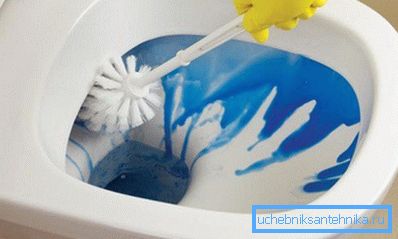
A friend without whom there is no way
Departure of natural needs is a delicate topic. Man, as a social being, tried to furnish this purely individual process in a civilized manner, changing the possibilities of nature to the toilet room. Modern porcelain and faience modern toilets can perform other functions besides the main one, for example, automatically flush water or carry out urine analysis.

Disturbing symptoms
No matter how high-tech these household items are, the problem of how to clean the toilet from limescale and rust stains can confound their owners.
The cause of stains on sanitary equipment can be:
- neglect of hygienic cleaning (in common areas, in rented apartments or in private properties with a chronic shortage of time);
- hard water;
- old sewer pipes;
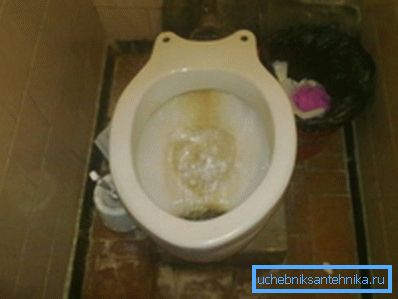
- untimely discharge;
- hot water destroying the surface;
- microcracks;
- the absorbency of the surface of the lavatory closet - in faience it is 10 to 12% higher than in porcelain;
- all-conquering laziness.

Before cleaning the toilet from lime scale, let's analyze the nature of sediments, which may be of different origin:
- Lime deposits - due to water hardness. Recall, if a container with settled water is shaken by careless movement, a cloudy precipitate rises from the bottom - this is lime, mineral salts and silicon. They are gradually washed, making the glazed surface roughened and improving the subsequent sedimentation process.
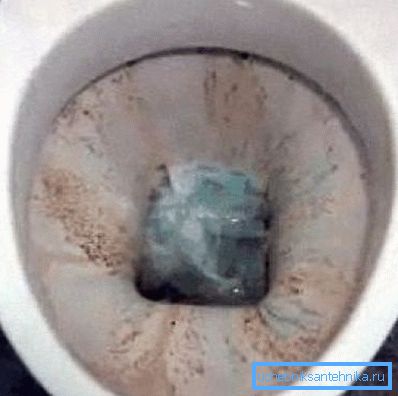
- Rusty spots - burping old heritage in the form of iron pipes with perennial deposits of rust that pollutes water.
- Urinary stone - deposits of solid minerals contained in urine. The stones have an extraordinary strength and have a dark brown color.
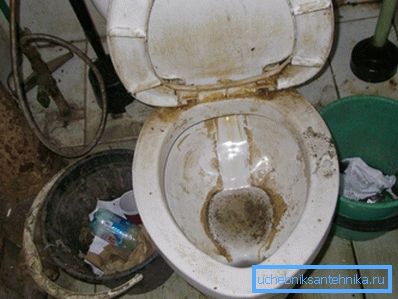
Note! In order not to suffer, than to wash the rust, hold a precautionary event? turn the float lever so that water does not flow constantly. Use special anti-rust tablets for water in the tank, which will add to it more fragrance and beautiful color.
Heavy hygienic weapons
Carefully study the composition of the cleaning gel or powder, as to get rid of limescale in the toilet can substances that contain acid. Here you need to be careful - during a chemical reaction salts form, which must be thoroughly rinsed with water, otherwise the enamel will collapse, such a procedure should be carried out no more than 1 time per month.
Working with aggressive compounds it is necessary to protect hands, respiratory organs, eyes. Therefore, gloves, glasses, a respirator or a gauze bandage should also be available, as well as the usual arsenal, than to clean the toilet from limescale: brushes, brushes, washcloths with a hard surface.
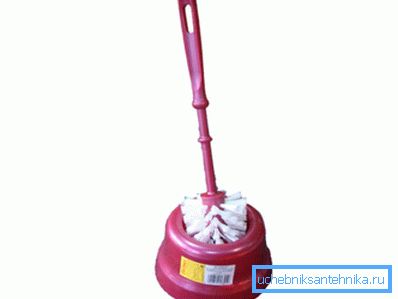
Note! Never use sharp metal objects, coarse abrasive cleaners. The price of such works will be too high - damaged enamel and scratches, which are tightly overgrown with precipitation.
Sediment control
The problem is always easier to prevent than to resolve, so you should simply clean up the latrine, no matter how unpleasant it may be. Removing lime scale from the toilet bowl at the initial stage will take little time and will not give a chance to the formation of mourning stains. But, if, due to reasons, the water closet has already “suffered”, there are many ways to cope with the disaster.
Traditional means
Household chemicals made a huge contribution to the resolution of the question of how to clean the toilet from limescale, offering powders, gels, liquids in bright packages. Domestos, Toilet duckling, Mr. Muskul, Mole, Arcanum (only for porcelain), Cillit can cope with not long-standing raids and should contain:
- sodium salts;
- sulfates;
- silicate;
- carbonate;
- Surfactants;
- acid (formic and sulfuric will perfectly remove lime and rust traces).
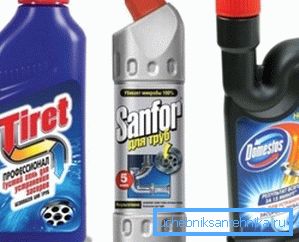
The instruction suggests applying the agent to the desired area, keeping for half an hour and re-processing. After rubbing with a brush, hard scourer or wooden stick and rinse. Do not remind you that you need to work in gloves.
Note! Despite the convenient nozzles, it is much more economical to apply the cleaning agent with your own hands.
To clean the seats below the waterline should:
- remove water using a plunger or a disposable cup (someone manages to do this with a vacuum cleaner);
- pour cleaner;
- wait an hour, periodically pouring means;
- scrape off deposits with a non-metallic scraper or brush;
- wash off.
Alternative cleansing
Folk recipes using modern substances can not suffer for a long time than to remove limescale from the toilet:
- "White"? in the "dehydrated" toilet for the night, pour the bottle, wash it in the morning;
- the use of acetic essence or citric acid requires ventilation and careful protection of the nasopharynx;
- 9% vinegar heated to 40 ° C - pour in, close the lid and leave overnight;
- Want to learn how to remove limescale from the toilet using Coca-Cola? Pour 0.5 liters of beverage into a dry toilet and hold for 2 hours.

With rust stains cope:
- 20% solution of tartaric acid, 20 ml of which is mixed with 80 ml of water;
- 5% solution of oxalic acid and water in the ratio of 5 to 95;
- 9 parts of hydrogen peroxide and 1 ammonia.
Solutions are applied to dirty areas, left for some time (substances from the last item for a few hours) and washed off.
Radical measures
Desperate in the question of how to remove old limescale and urinary stone, you can use the most drastic measures, at the same time and any evil in the pipes will get.
Cleaning is carried out with pumped water:
- hydrochloric acid - 2 tbsp. Sponge spoons on rust, lower the lid and after 20 minutes or a few hours, depending on the thickness of the plaque, rinse thoroughly. Your protection against toxic fumes should be maximized - goggles, gloves, respirator;
- the electrolyte is especially effective against the urinary stone - the liquid is poured into the toilet without splashing and then proceed as mentioned above; protection measures are the same.
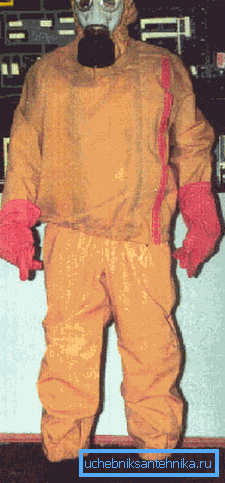
Note! If your plumbing pipes to the riser from the toilet bowl are plastic, the electrolyte cannot be used - it will corrode!
In conclusion
Not only the rich library and design of the apartment speaks about the cultural level and wealth of the owner, but also the state of the toilet bowl. Let the cleanliness of the toilet be the same habit as regular visits. This seemingly trifle can save a lot of time for a more pleasant pastime.
If you still have doubts about the effectiveness of any cleaning agent, the video in this article will dispel them.